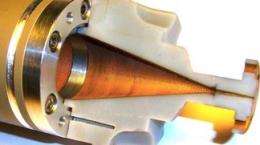Terahertz boost detection

Swissto12 -- an EPFL spin-off -- could help boost the performance of detection systems and create new antennas for mobile telephony and on-board satellite systems thanks to an innovative transmission system that takes advantage of a previously under-utilized wavelength: the terahertz.
What’s the common denominator between collecting meteorological data from space, searching for flaws on an aircraft fuselage, or using certain medical diagnostics? With terahertz waves, the targets of all of these could be more rapidly and precisely detected. These waves, whose frequency lies between the infrared band and the microwave band on the light spectrum, have the capability of characterizing surfaces or identifying the components of solids, liquids, even gases. So far considered harmless to human beings, terahertz waves have only been the subject of applied research for a few years. But Swissto12 is changing that.
"We are the first researchers to propose such performant transmission systems in the field of terahertz," explains Alessandro Macor, co-founder of Swissto12 with Emile de Rijk and Jean-Philippe Ansermet. The company, created only four months ago, offers a revolutionary system for guiding terahertz waves, or “T-rays.”
Swissto12’s secret is hidden in a seemingly innocuous metal tube with thousands of micro-washers of a particular diameter and profile stacked inside. Manufactured using high-tech materials, such as titanium, they direct the T-rays toward their target. This product paves the way for a much wider use of terahertz waves, enabling their propagation with minimal losses.
With the prototyping phase of its products complete, the start-up, located in the Scientific Park at Ecublens, was recently awarded two prizes designed to help young start-ups: Venture Kick and Innogrant. “We are already cooperating with several big companies that are testing new products functioning with T-rays,” confirms Alessandro Macor. The production is based on the know-how of companies in the region, in particular those that produce small watch-making parts and those working in precision engineering. The next stage aims at a further miniaturization of the system.
Provided by Ecole Polytechnique Federale de Lausanne
















